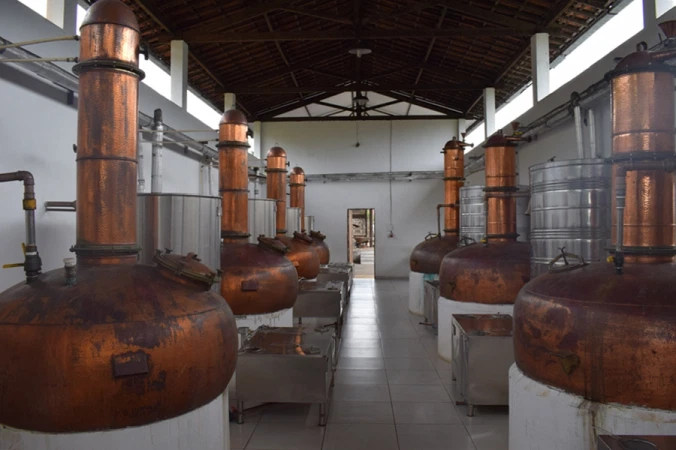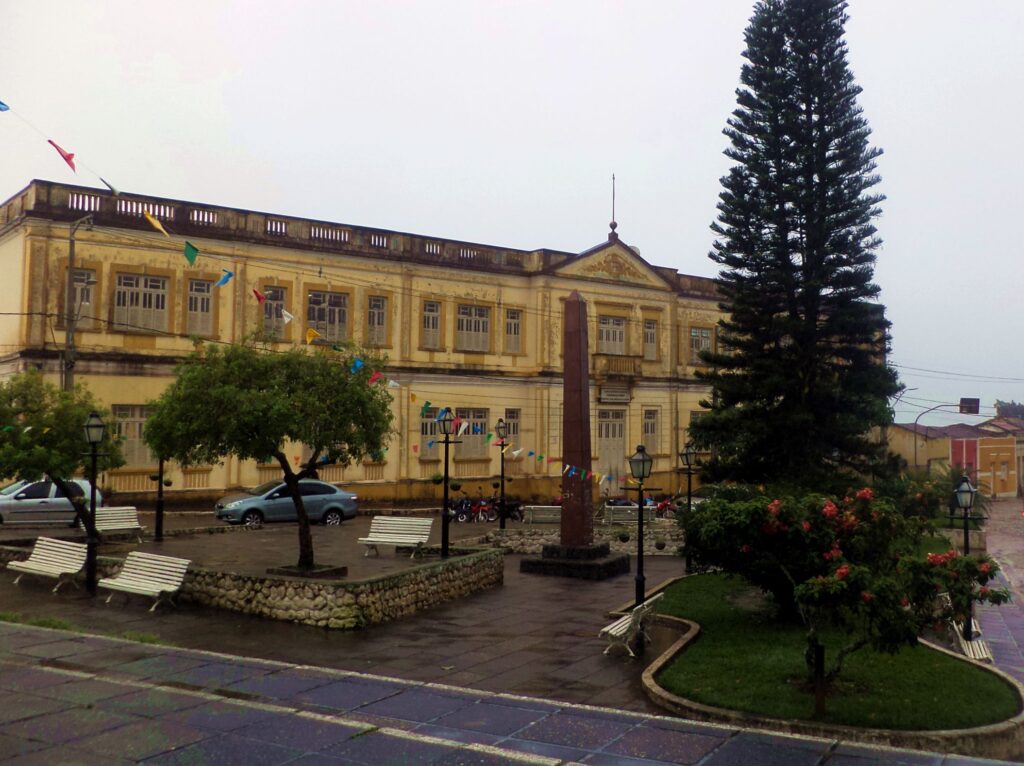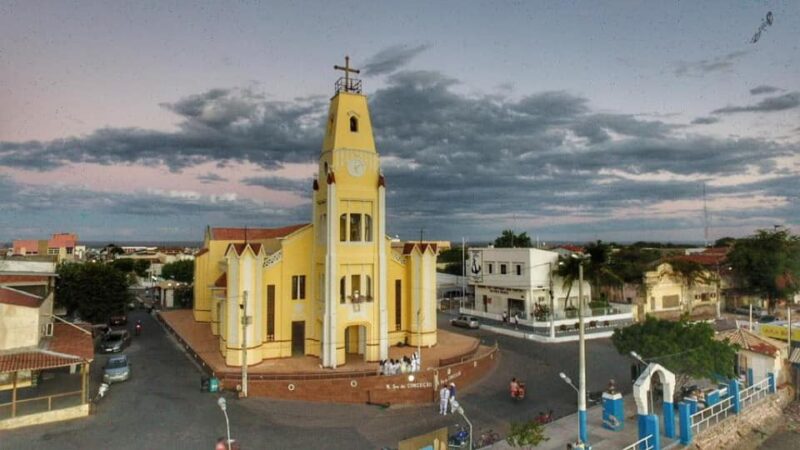Areia: History, culture and traditions of Brejo Paraibano
Areia was home to the first mills in Paraíba and has a great deal of history.
Nicknamed the “Princess of the Brejo, Areia prides itself on rarely exceeding 25 degrees in a Paraíba in full drought. In winter, the thermometer often drops below 10 degrees.
In the Paraiba town of Areia, this experience is accompanied by visits to mills, museums and the opportunity to embark on an authentic gastronomic expedition, which includes both rural roadside restaurants and more sophisticated ones.
The central area of the town retains its cobbled streets and colourful houses. The historical and urban complex is listed by the National Institute of Historical and Artistic Heritage.

The essence of the 18th and 19th centuries gives charm to the mansions, where it is customary for the inhabitants to leave a vase of flowers in the window.
To get there, just 130 kilometres from João Pessoa, you have to climb the Serra da Borborema. While in summer the breeze helps with the high temperatures, in winter visitors need to be prepared with trousers, boots and a coat.
The mountains are located in the brejo region of Paraíba, which explains the high temperatures. The coldest winter in the region was recorded at 12°C.
Brejo, in this case, does not refer to swampy areas; the name of the region comes from “brejos de altitude”, as the high areas of the Northeast are known, where a wetter climate prevails.

Cold paths
“Caminhos do Frio takes place in six mountain towns in the Brejo region of Paraíba: Areia, Bananeiras, Serraria, Pilões, Alagoa Nova and Alagoa Grande.
In 1625 Areia was known as Sertão dos Bruxaxás, a reference to the Bruxaxás tribe. This settlement was later elevated to the status of a town, with the name Vila Real do Brejo de Areia. Areia was the first city in Brazil to free its slaves, ten days before the Golden Law became official on 3 May 1888.
Situated at an altitude of more than 600 metres, the municipality enjoys a pleasant climate all year round, being one of the coldest in Paraíba. In winter, the temperature reaches 12ºC. The city has a peculiar architectural complex, both urban and rural, made up of churches, museums, public buildings, farms and mills that produce rapadura, brown sugar and the famous cachaças.

Kingdom of Sugar
“Sugar has sweetened so many aspects of Brazilian life that the national civilisation cannot be separated from it”. There are few places in northeastern Brazil where the words of Pernambuco sociologist Gilberto Freyre make as much sense as in the Brejo region of Paraíba.
In Areia alone, more than 100 mills were active between the mid-19th century and the end of the 1960s. Today, the few surviving 20 or so continue the tradition. Areia is home to the first steam-powered mills in Paraíba, such as the Engenho Vaca Brava, which opened in 1860 and is considered the oldest in the region.
The owner, Aurélio Leal, specialises in telling stories about the time when the farms had slave quarters and slaves milled the sugar cane. Today, the cachaça produced at Vaca Brava is still stored in umburana and jequitibá barrels.

Tourist attractions in the city of Areia PB
Areia has a strong culture, born of children who have left an unforgettable legacy in the history of the city and the country. The city is remembered as the land of painter Pedro Américo, writer José Américo de Almeida and Father Azevedo, inventor of the typewriter, among many other illustrious sons.


Areia PB - Guia de Turismo51:54

Engenho da Cachaça Triunfo em Areias PB05:56

Casa Pedro Américo em Areias PB01:41

Casarão José Rufino de Almeida em Areias PB01:41

Areia na Paraíba - Guia

Areia na Paraíba - Reportagem12:38
Known as the “Land of Culture“, Areia is home to the first theatre built in the State of Paraíba, the Minerva Theatre, built in the mid-19th century, as well as other historical buildings that are emblematic of the region’s culture.
1 Triunfo Cachaça Mill
The Triunfo Sugar Mill is an important historical monument in Paraíba and a walk through the history of sugar cane. Built in 1850, the mill has several historic buildings, such as the Big House, the Chapel and the Slave Quarters. It also offers guided tours and tastings of cachaça, one of the main products produced.

Cachaça Triunfo began in 1994 with the dream of Antônio Augusto. Although he wasn’t the son of a mill owner and didn’t have the knowledge to make cachaça, he bet on his dreams, faced the challenges, learnt about cachaça and today Triunfo sells more than 250,000 000 bottles a month and also exports, generating 69 direct jobs and more than 1,000 indirect jobs.
During the visit, tourists can learn all about the production process of Triunfo cachaça, taste sugar cane juice, cachaça juices and ice cream, and visit the brand’s product shop. The site also has a lake with pedal boats for children.
Address: Sítio Macaíba, S/N, Rural Area of Areia
2. Várzea do Coaty Mill
In existence since 2008, the Várzea do Coaty Mill is located in the rural area of Areia, in the district of Santa Maria. It is a place of history and regional character. The Casa Grande dates from the 1920s, with English architecture and one of the first houses built with cement. Another peculiarity is that the tourist centre still has the Caritó room, dedicated to virgins who didn’t marry young, hence the 16th century expression “ficar para o caritó”.
The tiled floor of the Casa Grande is original, as are the wide walls, characteristic of buildings of the period. The visit is accompanied by a guide who tells the stories of the family and the attraction.
Várzea do Coaty also has a regional restaurant that serves forró pé-de-serra and other dishes such as Gratinado ao Sol da Várzea (sun-dried meat, white cream and banana grilled in the oven), developed for the Saberes e Sabores project. The desserts are natural, with homemade jams made from seasonal fruit and milk from the animals on the property. The food consumed in the restaurant also comes from families in the region who work in family farming.
Address: District of Santa Maria, rural area of Areia
3. Pedro Américo House
The museum has been in existence since 1943. Visitors can see the unique original work “Cristo Morto” (Dead Christ) from 1901 and the replicas of the painter and writer from Areias, Pedro Américo: “O grito do Ipiranga (the original is in the Ipiranga Museum in São Paulo) and Batalha do Havaí (the original is in the Museum of Fine Arts in Rio de Janeiro).

The museum also houses original sketches made by the artist as a child and teenager, as well as photographs of Pedro Américo and his family. The museum is one of Areia’s most visited attractions because of its historical importance. The place where the writer was born in 1843 was founded to commemorate his centenary in 1943.
Pedro Américo followed the trends of Romanticism in Brazil, a period in which artists sought to valorise nationalism by portraying important historical facts and contributing to the formation of a national identity.
Hours of operation: Every day from 8am to 6pm, with half-price and full-price admission.
Address: Rua Pedro Américo, 66
4. Minister José Américo de Almeida Square
A Square built in 1980 in honour of the writer, politician and minister José Américo de Almeida, author of works such as A bagaceira and responsible for bringing the state’s first university to Paraíba.

5. José Rufino de Almeida Mansion
Built in 1818 by the Portuguese Francisco Jorge Torres, entering the mansion is like stepping back in time. The building was the first sobrado built in Vila Real de Areia and is recognised as the only urban senzala in Paraíba.
The building preserves the original structure of the walls and architecture, and even with the restoration, with replicas of the floorboards and some other spaces such as balconies, the mansion doesn’t lose its charm. On the ground floor, there was a trade in various products, from silk to hand-rolled tobacco. On the first floor lived the Portuguese man’s family, and at the back of the house were the slave quarters with 12 cubicles, each measuring 2m40 x 2m40, which held between 8 and 12 black men and women.
In the centre was a pillory where blacks were tortured as an example to others. Under the roof of the mansion you can see the formation of the eiras, beirairas and tribeiras. This architecture represented to society the economic level of a family; the more eiras a family had, the richer they were, hence the expression “so-and-so has no eira or beira”.
Today, the Casarão is Areia’s main historical and artistic attraction. The room pays tribute to men and women who contributed to the economic, political, religious, social and cultural development of Paraíba. The cabins (6 units on the ground floor and another 6 on the first floor) now serve as a library, housing books on the history of Paraíba and Brazil.
Address: Praça Pedro Américo and Praça João Pessoa
6. Minerva Theatre – Paraíba’s first theatre
Built by the hands of slaves and with architecture that reflects the region’s golden age, the Minerva Theatre is a must on any tour of the city’s historic monuments. Inaugurated in 1859 in the Baroque style, the building is notable for its rich wooden details, making it an architectural relic.

It’s impossible not to be enchanted by the atmosphere that pervades the building, taking you back to a time when great European companies performed on its stage to the delight of plantation owners.

7. Mother Church of Our Lady of the Conception
The Igreja Matriz de Nossa Senhora da Conceição (Mother Church of Our Lady of the Conception), built with only one central tower, allows you to travel back in time and bears witness to the original focus of the town, which grew with the exploitation of sugar cane. On the site of the Cathedral, there was originally only a thatched house which, after successive renovations, has become a valuable example of the colonial quality that makes Brejo a laboratory for students and lovers of architecture.

Anyone who loves baroque art should visit the Nossa Senhora da Conceição Mother Church in Areia, Paraíba, next to Bananeiras. Its ceiling is entirely painted, a true and legitimate reference to the 19th century baroque art of Paraiba. In addition to the sacred images and the ancient tiled floors, which complete the atmosphere of art and culture.

8. Church of Nossa Senhora do Rosário dos Pretos
Just as important as the Parish Church is the Nossa Senhora do Rosário dos Pretos Church, one of the oldest in the State, built by slaves and with its own style. From its windows you can see Areia with its well-decorated squares and cobblestone streets.

Although there are no concrete data, it is known that the Church of the Rosary is one of the oldest in Paraíba. Its construction began in the mid-18th century and was completed in the 19th century, in 1886, with the arrival of a sum of four contos de réis granted by the Paraíba provincial government. Also in 1886, the first religious festival was held in the Church of Rosário.
In 1873, Father Antônio José Borges, authorised by Vicar Odilon Benvindo, founded the Brotherhood, which still exists today. In 1952 the Brotherhood of the Rosary ceased its activities, but they were resumed in 1989. Slaves were responsible for the labour used in the construction and history of Areia.
9. Art Space
Espaço da Arte is where an association brings together the work of 10 artisans from the town of Areia, who work with different materials such as fabric, ceramics, wood, threads (crochet and knitting) and offer very elaborate pieces such as kitchen sets, paintings on canvas, as well as cachaças, rapaduras, honey and liqueurs produced in Areia.
Address: Rua Pedro Américo, S/N
History of the city of Areia in Paraíba
In the process of settling the interior of Paraíba, Areia originated as a strategic stopping point and shelter for the drovers who came from the hinterland to the coast to sell their products. At the end of the 17th century and the beginning of the 18th century, the town was first called Sertão do Buxaxá (“land where the cicada sings”). Buxaxás were the Indians who originally inhabited the region.
It was around this time that a Portuguese man built a hostel on the site of the present town, on the edge of a crossroads frequented by travellers and muleteers coming from the highlands of Paraíba or Pernambuco on their way to other towns in the region. The settler was nicknamed Buxaxá because of his friendship with the natives. The movement through the area attracted inhabitants and soon a prosperous settlement was formed, which was renamed Brejo de Areia, after the stream called Areia that ran through the area.
The district was created in 1813 under the name of Brejo d’Areia, subordinated to the town of Monte-Mor. The commune was separated from the town of Monte-Mor (now Mamanguape) in 1815, and the town was elevated to the category of village in 1815. In 1846 it became a town and the seat of a municipality under the name of Areia, which is also remembered for the participation of its inhabitants in important political movements in the 19th century.
The population joined the liberation movement in Pernambuco and took part in the Confederação do Equador (1817) and Revolução Praieira (1848) revolutions. During the Confederation, the troops of Sergeant Major Félix Antônio Ferreira de Albuquerque set out from Areia (the temporary seat of the province) to fight the legal forces. These men were joined by the remnants of Pais de Carvalho‘s battalions and marched to Ceará, where they were annihilated. In February 1849, the last battle of the Praieira Revolution took place in Areia.
After the unsuccessful attack on Recife, the rebels invaded Paraíba and took refuge in Areia, where they received help from the magistrate Maximiano Lopes Machado and Colonel Joaquim dos Santos Leal. They entrenched themselves in the city and fought for six hours before fleeing and scattering inland.
In the city, the abolitionist campaign was one of the most intense, with the Mocidade Emancipadora Areiense led by Manuel da Silva standing out. The people of Arei freed the last slave on 3 May 1888, ten days before the proclamation of the Golden Law.
This post is also on:
![]() Português
Português ![]() English
English ![]() Deutsch
Deutsch ![]() Español
Español ![]() Français
Français



















